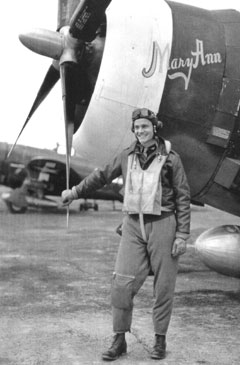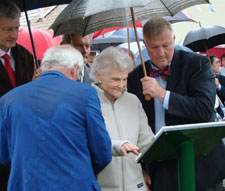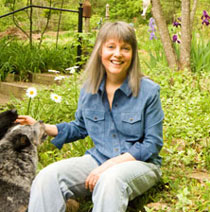UAB Filmmaker Chronicles a Journey of Discovery
By Matt Windsor
 When Captain Malcolm A. Smith's P-47 Thunderbolt fighter (above) crashed in the French countryside in 1944, his family was told it was an accident. Sixty years later, they learned the real story. Smith's niece, UAB filmmaker June Mack, tells the tale in a documentary that will premiere at UAB on November 10. On May 21, 1944, Captain Malcolm A. Smith’s P-47 Thunderbolt fighter fell out of the skies over northwestern France. The U.S. Army Air Corps, suspecting weather trouble, informed Smith’s family in Alabama of the loss, but kept his status as “missing in action” for another two years before acknowledging he would never return.
When Captain Malcolm A. Smith's P-47 Thunderbolt fighter (above) crashed in the French countryside in 1944, his family was told it was an accident. Sixty years later, they learned the real story. Smith's niece, UAB filmmaker June Mack, tells the tale in a documentary that will premiere at UAB on November 10. On May 21, 1944, Captain Malcolm A. Smith’s P-47 Thunderbolt fighter fell out of the skies over northwestern France. The U.S. Army Air Corps, suspecting weather trouble, informed Smith’s family in Alabama of the loss, but kept his status as “missing in action” for another two years before acknowledging he would never return.
Sixty years later, Smith’s sister, Marianne Smith Morgan, received a letter from a Frenchman who said he had discovered what really happened on that fateful Sunday afternoon. Smith had actually been killed in action in a dogfight with a German warplane—and he had become a beacon of hope for the villagers of Vibraye, a tiny community near his crash site.
“At first we thought it was a hoax,” says June Mack, M.F.A., Morgan’s daughter and an award-winning filmmaker on the faculty in the UAB Department of Communication Studies. But Mack soon discovered she had become a part of an incredible true story of redemption, gratitude, and hope. She eventually turned the tale into a documentary, Lest We Forget: A French Village Recalls 1944. The film will get its public premiere on Saturday, November 10, 2012—Veteran’s Day weekend—at 4:00 p.m. in UAB’s Hulsey Center Recital Hall, room 108.
Path of Honor
The story owes its life to Jacky Emery, a French citizen whose hobby is finding villages in areas of France where Allied soldiers died or were wounded. “He does it simply because he is so grateful for what they did during the war,” Mack says. “He goes to the towns and suggests that they use their next building project—a new road, building, or bridge—to honor the soldier.”
 When Captain Smith's plane crashed outside the village of Vibraye in 1944, its citizens made the Allied airman a symbol of all those who were fighting for their freedom. In 2009, the Smith-Morgan family, including Marianne Smith Morgan (above, center), Mack's mother and Captain Smith's sister, traveled to Vibraye for the dedication of Rue Malcolm A. Smith. When he contacted Marianne Morgan in 2004, Emery reported that the citizens of Vibraye had never forgotten the American pilot who had crashed outside their village. “No other planes went down in the area,” Mack says. “They were occupied by the Germans at the time, and they went to extraordinary lengths to get the body and bury it in their cemetery. They would sneak out to put flowers on his grave, and they’ve kept flowers on that grave ever since. My uncle became their symbol for all the others who were fighting for them.”
When Captain Smith's plane crashed outside the village of Vibraye in 1944, its citizens made the Allied airman a symbol of all those who were fighting for their freedom. In 2009, the Smith-Morgan family, including Marianne Smith Morgan (above, center), Mack's mother and Captain Smith's sister, traveled to Vibraye for the dedication of Rue Malcolm A. Smith. When he contacted Marianne Morgan in 2004, Emery reported that the citizens of Vibraye had never forgotten the American pilot who had crashed outside their village. “No other planes went down in the area,” Mack says. “They were occupied by the Germans at the time, and they went to extraordinary lengths to get the body and bury it in their cemetery. They would sneak out to put flowers on his grave, and they’ve kept flowers on that grave ever since. My uncle became their symbol for all the others who were fighting for them.”
Emery also reported that Vibraye planned to use its next public works project to honor Captain Smith, and he hoped Morgan and her family would travel to France as guests of honor at the ceremony. Five years later, in 2009 (“it’s a very little town,” Mack says), there was finally some new construction: A road was being built, which would be named Rue Malcolm A. Smith.
Living History
As the date approached, more and more family members signed on to take the trip. Eventually, a party of 20 headed for France. “They were waiting for us when we drove into town—two hours late,” Mack says. Four days of festivities followed, including visits with a local countess, stories in the newspaper, parties, songs of remembrance at the crash site, and the ribbon cutting itself.
 Mack, who directs the individually designed major in film and the interdisciplinary film minor at UAB, says the trip was a life-changing experience. Photo credit: Randall Taylor One highlight was a meeting with all seven living witnesses to Captain Smith’s crash. “Between us, on a table covered with a U.S. flag, were parts of the engine that they had recovered from the site and kept all these years,” Mack says. Speaking through translators, “each witness told what they had seen—one was a teenager who was sent to get the body, another was in her garden picking flowers and watched the body pass, and others saw the shooting and the plane go down.”
Mack, who directs the individually designed major in film and the interdisciplinary film minor at UAB, says the trip was a life-changing experience. Photo credit: Randall Taylor One highlight was a meeting with all seven living witnesses to Captain Smith’s crash. “Between us, on a table covered with a U.S. flag, were parts of the engine that they had recovered from the site and kept all these years,” Mack says. Speaking through translators, “each witness told what they had seen—one was a teenager who was sent to get the body, another was in her garden picking flowers and watched the body pass, and others saw the shooting and the plane go down.”
The people of Vibraye had hired a videographer to record the discussion and the other events. Mack, who had brought her own camera, recorded interviews and additional footage. “My mother, now 87 years old, is the storyteller in the film,” Mack says.
It took Mack a year to edit the footage into a two-and-a-half-hour feature and the condensed, one-hour version that she will show at UAB on November 10. “I originally made it just for the family,” Mack says, “but everyone who saw it said, ‘You need to show this.’”
The trip, and the people her family met, “changed our lives forever,” Mack says. “It was a powerful lesson in gratitude and humility, about how one person can affect so many others.”
More Information
To learn more about UAB's individually designed major in film, contact June Mack by e-mail or at (205) 934-3852.